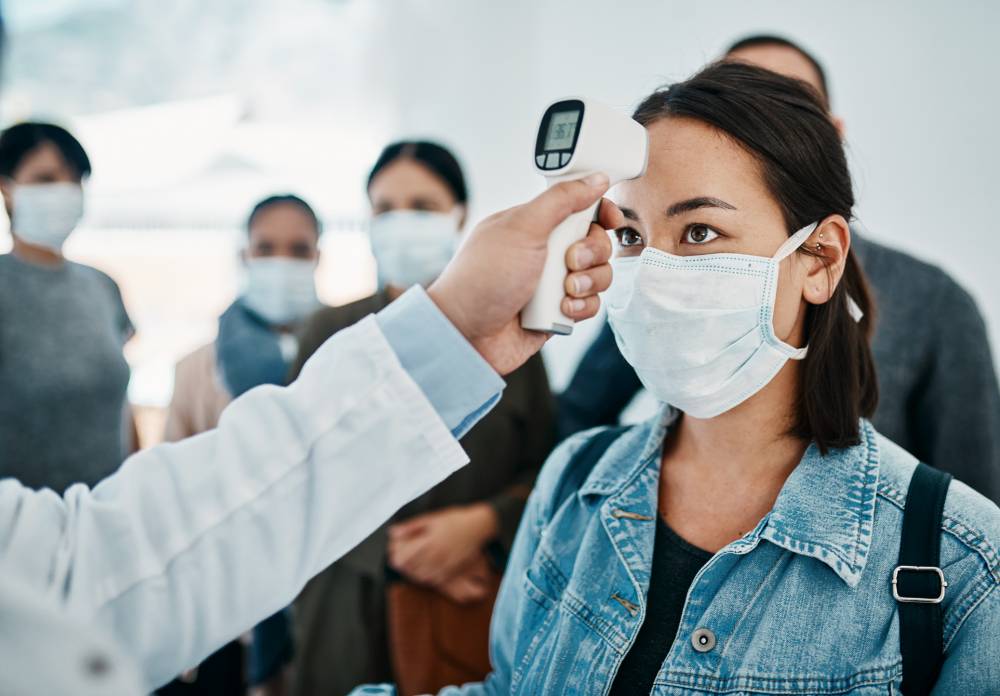
By now, we are all familiar with presenting our foreheads for temperature monitoring when we walk into public spaces.
In the new world of COVID-19 precautions, tracking people’s temperature has become one of the many additional screening and prevention methods adopted by organisations.
But with studies showing that people who have contracted COVID-19 can be contagious for days before developing a fever, does temperature checking play a useful role in infection control?
Research says temperature scanners have ‘limited value’ in detecting COVID-19
A number of recent studies have explored the usefulness of infrared thermographic screening – or non-contact thermometers to use the more common terminology.
Non-contact thermometers determine temperature by measuring the heat emanating from the surface of a person’s body, often the forehead.
However, research by Professor Mike Tipton, a human physiologist and expert in temperature regulation, recently published in Experimental Physiology, stated that “measuring skin temperature doesn’t give an accurate estimation of deep body temperature (raised in a fever).”
Skin temperature can be imprecise and impacted by a number of factors such as exercise, air temperature or even if someone has taken medication.
And so use of the infrared guns, the kind we are all now all too familiar with, is “an unreliable method to detect the fever associated with Covid-19.”
The accuracy of non-touch thermometers was also questioned in a December study published in the American Journal of Infection Control which revealed that infrared screening missed five out of six fevers.
In the spotlight in Australia
In the fight against COVID, infrared devices have proven to be one of the weapons of choice in Australia in a bid to keep public places open and safe.
However, a recent article published by The Age, has raised further concerns about the usefulness of these devices.
Speaking with University of Melbourne principal research fellow professor Fiona Russell, The Age states that concerns about these devices are on the rise with Australia’s Health Watchdog reportedly receiving 44 complaints about infrared thermometers over the past ten months – the majority related to accuracy.
Fiona Russell told The Age that “these kinds of infrared thermometers cannot reliably detect a fever because they measure the surface temperature of the skin rather than taking the core body temperature.”
No surprises
These concerns are certainly not new. In fact, as early as May 2020 a white paper published in America by the ACLU warned of a “gold rush” of companies bringing fever detectors to the market. With the result of “accuracy levels that appear to be all over the map.”
Closer to home, Therapeutic Goods Administration has issued a number of fines since mid-2020 to businesses selling infrared devices for breaches of the Therapeutic Goods Act, including false advertising.
Unfortunately, there is no magic bullet in the detection of a COVID-19 infection, and testing remains the most accurate way to detect infection.
While temperature monitoring systems may bring people peace of mind while they’re out and about, most research seems to agree that they provide inaccurate information providing false reassurance or unnecessarily limiting people access and entry to spaces.
Maintaining social distancing, wearing masks, and getting tested if you display symptoms is still the best way that the public can help slow the spread.
How can I choose the right thermometer?
If you’ve made the decision to enforce temperature checking before people enter your place of work or facility, then be sure to choose a compliant temperature-taking device for your organisation. You can do a quick check to see if the company you are planning on using is registered on the Australian Register of Therapeutic Goods website, which is a complete catalogue of the medical devices that can be legally supplied in Australia.
If you have concerns you can also contact the TGA directly by calling 1800 020 653 or emailing devices@tga.gov.au to ask advice.
My employer purchased a number of non-contact infrared thermometers. Three were for my service to utilise. They were around $100 each. I don’t think that could be considered cheap. They are hopeless. They would get too cold in winter and then just not work. Poor effort by manufacturer.
Thought this for ages. Everyone is always the same temperature unless it is hot outside or cold! The best method is still the under the tongue or in the ear. Checked the best method on line one day! Half the time the nurses don’t give too hoots how the staff are doing their temperatures. Sitting at their desks not wanting to be bothered. Half the time there is no thermometer to be found at the start of your shift. Oh well. That’s aged Care for you. Another issue is all the new visa holders swamping the industry with hardly any English skills or training. Just a means to an end I suppose. With so many Australians out of a job you would think the government would make it more attractive to hire Australian citizens first in the Aged Care sector. Oh. I forgot. They whinge when the workload gets too much or their pay is looking a bit dodgy. And goodness for bid they join a union!